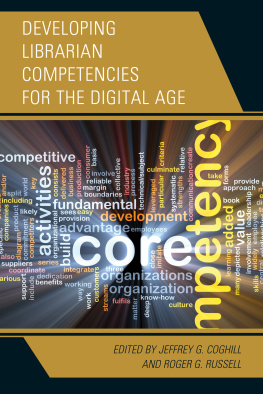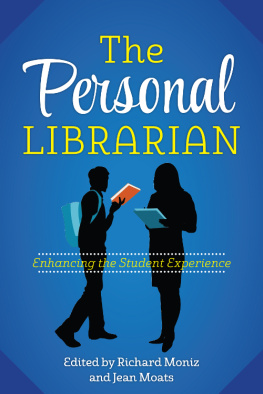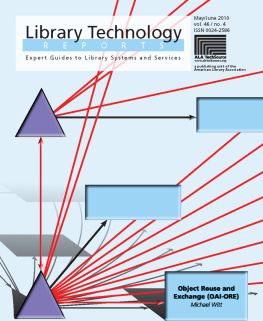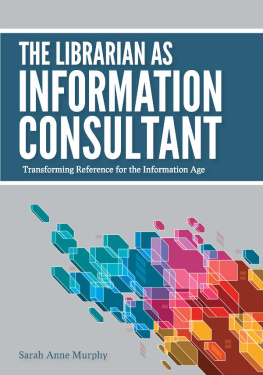Developing Librarian Competencies for the Digital Age
Medical Library Association Books
The Medical Library Association (MLA) features books that showcase the expertise of health sciences librarians for other librarians and professionals.
MLA Books are excellent resources for librarians in hospitals, medical research practice, and other settings. These volumes will provide health care professionals and patients with accurate information that can improve outcomes and save lives.
Each book in the series has been overseen editorially since conception by the Medical Library Association Books Panel, composed of MLA members with expertise spanning the breadth of health sciences librarianship.
Medical Library Association Books Panel
Kristen L. Young, AHIP, chair
Dorothy Ogdon, AHIP, chair designate
Michel C. Atlas
Carolann Lee Curry
Kelsey Leonard, AHIP
Karen McElfresh, AHIP
JoLinda L. Thompson, AHIP
Heidi Heilemann, AHIP, board liaison
About the Medical Library Association
Founded in 1898, MLA is a 501(c)(3) nonprofit, educational organization of 3,500 individual and institutional members in the health sciences information field that provides lifelong educational opportunities, supports a knowledgebase of health information research, and works with a global network of partners to promote the importance of quality information for improved health to the health care community and the public.
Books in the Series
The Medical Library Association Guide to Providing Consumer and Patient Health Information edited by Michele Spatz
Health Sciences Librarianship edited by M. Sandra Wood
Curriculum-Based Library Instruction: From Cultivating Faculty Relationships to Assessment edited by Amy Blevins and Megan Inman
Mobile Technologies for Every Library by Ann Whitney Gleason
Marketing for Special and Academic Libraries: A Planning and Best Practices Sourcebook by Patricia Higginbottom and Valerie Gordon
Translating Expertise: The Librarians Role in Translational Research edited by Marisa L. Conte
Expert Searching in the Google Age by Terry Ann Jankowski
Digital Rights Management: The Librarians Guide edited by Catherine A. Lemmer and Carla P. Wale
The Medical Library Association Guide to Data Management for Librarians edited by Lisa Federer
Developing Librarian Competencies for the Digital Age edited by Jeffrey G. Coghill and Roger G. Russell
Developing Librarian Competencies for the Digital Age
Edited by
Jeffrey G. Coghill
Roger G. Russell
ROWMAN & LITTLEFIELD
Lanham Boulder New York London
Published by Rowman & Littlefield
A wholly owned subsidiary of The Rowman & Littlefield Publishing Group, Inc.
4501 Forbes Boulevard, Suite 200, Lanham, Maryland 20706
www.rowman.com
Unit A, Whitacre Mews, 26-34 Stannary Street, London SE11 4AB
Copyright 2017 by Medical Library Association
All rights reserved. No part of this book may be reproduced in any form or by any electronic or mechanical means, including information storage and retrieval systems, without written permission from the publisher, except by a reviewer who may quote passages in a review.
British Library Cataloguing in Publication Information Available
Library of Congress Cataloging-in-Publication Data Available
ISBN 978-1-4422-6443-4 (cloth : alk. paper)
ISBN 978-1-4422-6444-1 (pbk. : alk. paper)
ISBN 978-1-4422-6445-8 (ebook)
 TM The paper used in this publication meets the minimum requirements of American National Standard for Information Sciences Permanence of Paper for Printed Library Materials, ANSI/NISO Z39.48-1992.
TM The paper used in this publication meets the minimum requirements of American National Standard for Information Sciences Permanence of Paper for Printed Library Materials, ANSI/NISO Z39.48-1992.
Printed in the United States of America
Preface
Change is inevitable. Libraries, librarianship, and the expectations of library users seem to be in a continual state of change. Predicting future changes with accuracy is nearly impossible. We can, however, identify trends that help us understand what the future might bring. Current trends hint at profound changes and more. Other factors, such as changes in funding models for higher education, changes in publishing, the uncertain future of the tenured faculty model, and the aging of the librarianship as a profession, all compound with emerging technologies to create an environment ripe for substantive change. The trends suggest that there are more opportunities than ever before for librarians and for those with other degrees to expand traditional roles into new areas of work and expertise in libraries.
Emerging technologies in higher education have shifted student usage trends in libraries.
Librarians are devoting great amounts of time, effort, and funding to tracking and interpreting transformative trends. In May 2014, the American Library Association, the largest library-focused organization in the world, announced the launch of the Center for the Future of Libraries. Other such organizations are likewise transfixed by the prophetic prospects of reading the trends. What does the future hold for libraries and user experience, makerspaces, and delivery of mobile content? What do trends in virtual and augmented reality such as the development of libARi and digital-print interface technologies like FingerLink and Nimble mean for libraries? How might trends in open education resources, research data management, open access publishing, and data visualization change libraries? What can trends in library design and library leadership tell us about our future? This book focuses on what it means to a librarian in the twenty-first century. It is divided into ten chapters. Chapter 1 focuses on the foundations of librarianship and the move toward the new librarian. Chapter 2 covers the sources of information and collections found in the modern library. Chapter 3 examines the organization of knowledge and information. Technical knowledge and skills is the theme of chapter 4. Chapter 5 examines reference and user services in the twenty-first century. Chapter 6 concentrates on the research abilities necessary for librarians to thrive in the library. Chapter 7 relates to the marriage of continuing education and new ways of teaching that have changed library services to clients both on and off campus. Chapter 8 analyzes new ways that library administrators are adapting to managing a library in the twenty-first century. Chapter 9 examines core competencies across the profession as outlined by professional organizations such as the Medical Library Association (MLA), the American Library Association (ALA), and Special Libraries Association (SLA), to name a few. Finally, chapter 10 examines who library patrons of the future might be and how library services could change to meet their needs. The intended audience for this book is library professionals at any stage in their careers or in any library setting to become proactive in coping with the near-constant state of change affecting all libraries and all library users in the modern era.
Notes
Erin Dorris Cassidy, Angela Colmenares, Glenda Jones, Tyler Manolovitz, Lisa Shen, and Scott Vieira, Higher Education and Emerging Technologies: Shifting Trends in Student Usage, The Journal of Academic Librarianship 40, no. 2 (2014): 12433.
J. Raju, Knowledge and Skills for the Digital Era Academic Library,







 TM The paper used in this publication meets the minimum requirements of American National Standard for Information Sciences Permanence of Paper for Printed Library Materials, ANSI/NISO Z39.48-1992.
TM The paper used in this publication meets the minimum requirements of American National Standard for Information Sciences Permanence of Paper for Printed Library Materials, ANSI/NISO Z39.48-1992.